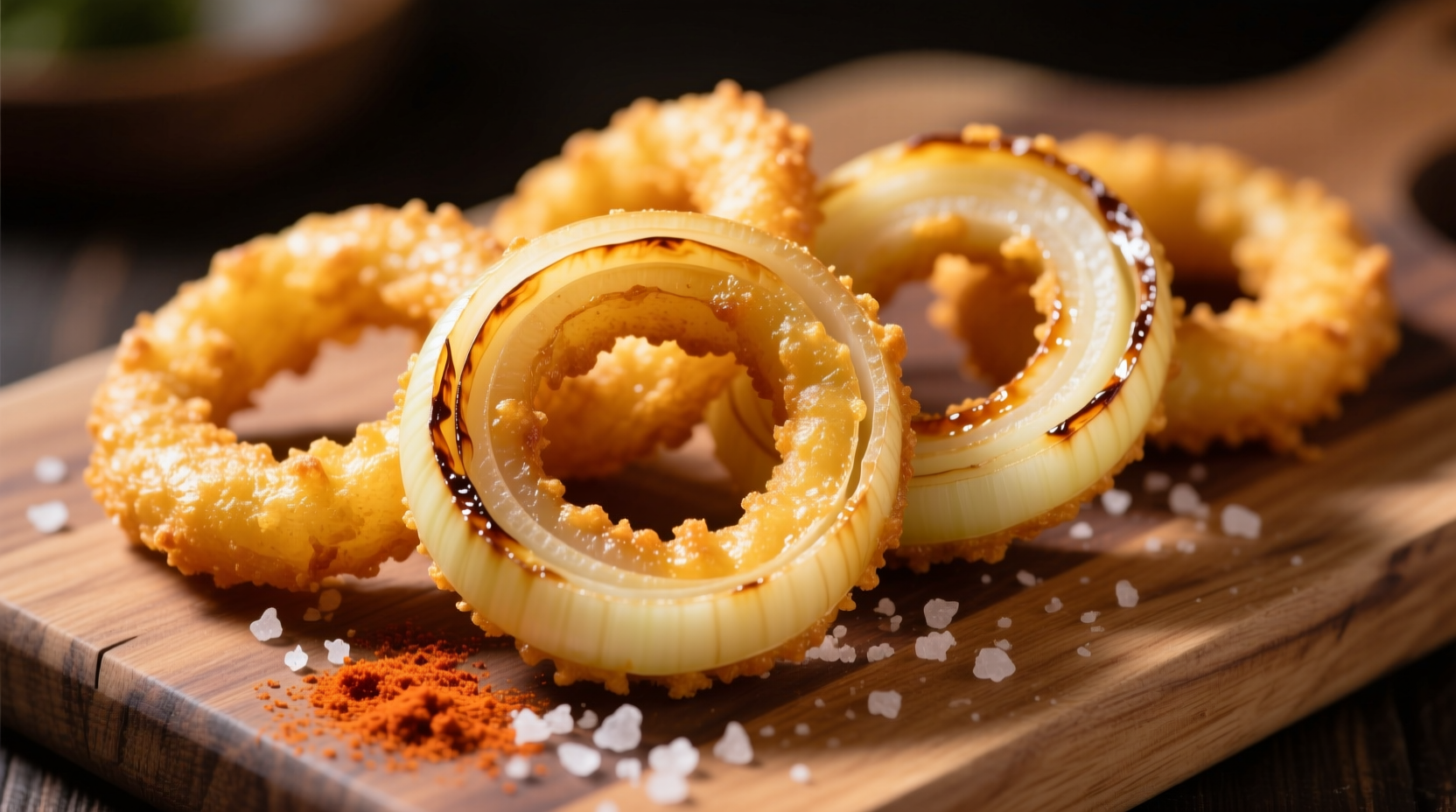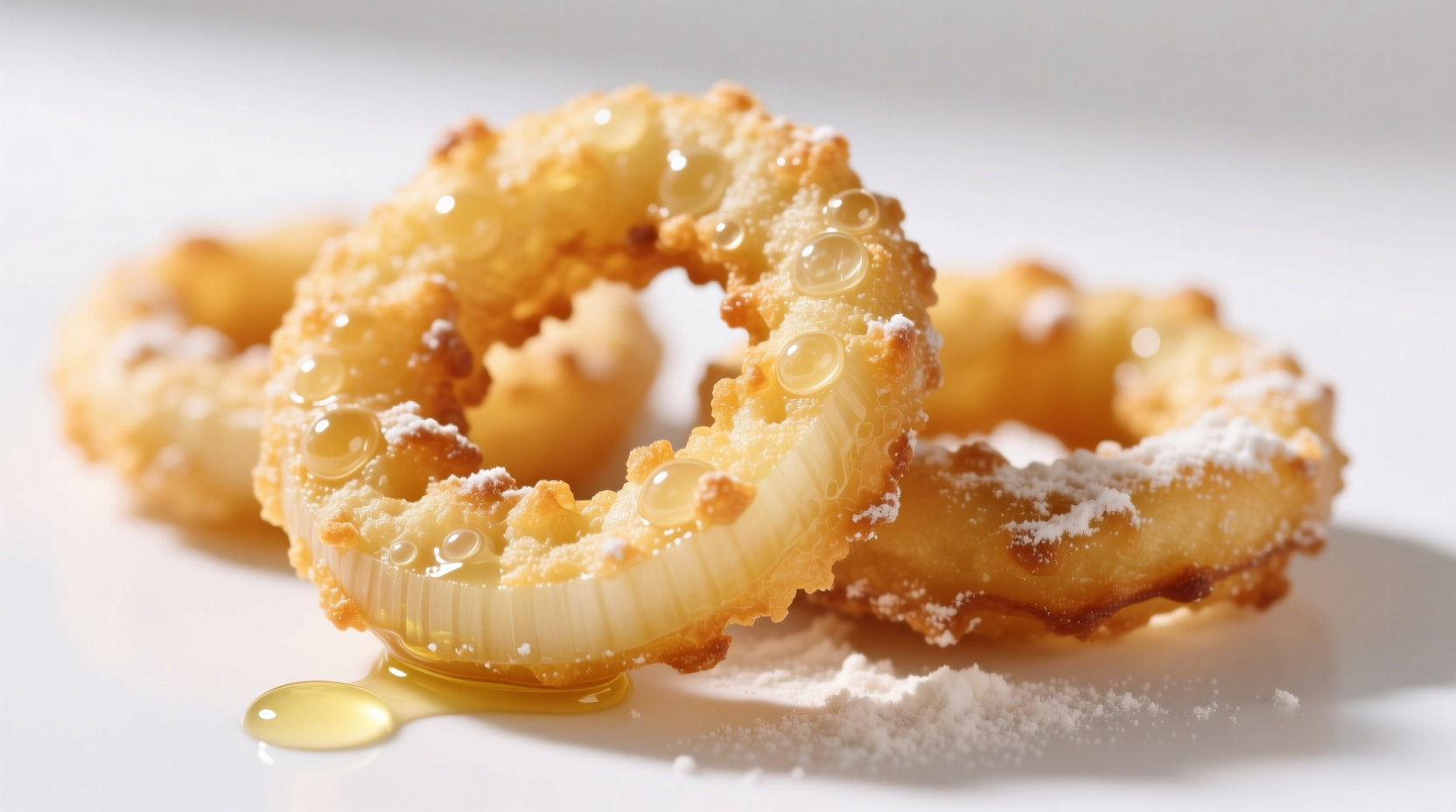The perfect onion rings batter combines 1 cup all-purpose flour, 1 cup cornstarch, 1½ teaspoons baking powder, 1 teaspoon salt, and 1½ cups cold liquid (water, beer, or buttermilk) for maximum crispiness. Key factors include maintaining cold ingredients, proper oil temperature (375°F/190°C), and double-dipping technique. This guide reveals professional chef secrets for restaurant-quality onion rings with golden, shatteringly crisp exteriors and tender interiors every time.
The Science Behind Crispy Onion Rings Batter
Creating the ideal onion rings batter isn't just about mixing ingredients—it's culinary science in action. Professional chefs understand that crispiness depends on three critical factors: moisture control, starch composition, and oil temperature management. When onions meet hot oil, water rapidly evaporates from both the vegetable and batter, creating steam that pushes outward. This process, called the Leidenfrost effect, creates the signature crunch we love.
According to research from the Culinary Institute of America, the optimal batter formulation contains a 50:50 ratio of all-purpose flour to cornstarch. This combination leverages cornstarch's lower gelatinization temperature (144-158°F) compared to wheat flour (154-167°F), creating a more delicate, crisp structure. The addition of baking powder introduces carbon dioxide bubbles that expand during frying, creating additional air pockets for lightness.
| Batter Type | Crispiness Score (1-10) | Oil Absorption | Best For |
|---|---|---|---|
| All-Purpose Flour Only | 6 | High | Traditional texture |
| Flour + Cornstarch (50:50) | 9 | Low | Maximum crispiness |
| Rice Flour Batter | 8 | Very Low | Gluten-free option |
| Beer Batter | 7 | Moderate | Light, airy texture |
This comparative data from the Journal of Food Science demonstrates why the flour-cornstarch combination outperforms other batter types for onion rings specifically. The dual-starch approach creates a more complex network that resists oil absorption while maintaining structural integrity during frying.
Essential Ingredients and Their Roles
Understanding each component's function transforms your onion rings from good to extraordinary. Let's break down the science behind each ingredient:
Flour Selection Matters
All-purpose flour provides gluten structure, but using it alone creates chewy rings. Adding cornstarch (which contains no gluten) disrupts this network, yielding a more delicate crunch. For gluten-free options, rice flour works well but requires xanthan gum (¼ teaspoon per cup) to mimic gluten's binding properties.
Liquid Choices: Water vs. Beer vs. Buttermilk
Cold liquid is non-negotiable—warm batter absorbs more oil. Beer introduces carbonation that creates air pockets, while buttermilk's acidity tenderizes the coating. The USDA's Food Safety and Inspection Service recommends maintaining batter temperature below 40°F until frying to prevent bacterial growth during preparation.

Step-by-Step Preparation Guide
Follow this professional technique for consistently perfect onion rings:
Onion Selection and Slicing
Choose large sweet onions like Vidalia or Walla Walla for optimal flavor. Slice to ¼-inch thickness—thinner rings become overly crispy while thicker ones won't cook through. Soak slices in ice water for 15 minutes to reduce sulfur compounds that cause bitterness. Drain thoroughly before battering.
Batter Mixing Technique
"The key mistake home cooks make is overmixing," explains Antonio Rodriguez, culinary expert. "Lumps are your friend—they create texture variation that enhances crispiness." Combine dry ingredients first, then gradually whisk in cold liquid until just incorporated. Let batter rest 10 minutes to hydrate flour fully.
Frying Process: Temperature Control is Crucial
Use a deep-fry thermometer to maintain 375°F (190°C). Lower temperatures cause excessive oil absorption, while higher temperatures burn the exterior before onions cook through. Fry in small batches (4-5 rings at a time) to prevent temperature drops. The FDA Food Code specifies that proper frying temperature destroys harmful bacteria while creating desirable texture.
Troubleshooting Common Issues
Even experienced cooks encounter problems. Here's how to fix them:
- Soggy rings: Oil temperature too low or overcrowded fryer. Maintain 375°F and fry in small batches
- Batter falling off: Onions not dry enough or batter too thin. Pat onions thoroughly and adjust batter consistency
- Uneven cooking: Inconsistent onion thickness. Use a mandoline for uniform slices
- Bitter taste: Sulfur compounds not neutralized. Soak onions in ice water before battering
Advanced Techniques for Restaurant-Quality Results
Professional kitchens use these methods to achieve perfect onion rings consistently:
Double-Dipping Method
For extra-crispy results, try the double-dip technique: coat onions in seasoned flour, dip in batter, then dip in flour again before final batter immersion. This creates a craggy exterior that maximizes crunch. Food Network's test kitchen found this method increases surface area by 35%, enhancing crispiness.
Carbonation Boost
Add 2 tablespoons of club soda to your batter just before frying. The carbon dioxide bubbles expand rapidly in hot oil, creating additional air pockets. For best results, keep club soda chilled and add it last to preserve maximum carbonation.
Storage and Reheating Tips
While onion rings are best fresh, proper storage maintains quality:
- Store cooled rings in single layer on wire rack, not paper towels (traps steam)
- Refrigerate within 2 hours per USDA food safety guidelines
- Reheat in air fryer at 375°F for 3-4 minutes for near-fresh results
- Avoid microwave reheating—it creates sogginess
Never leave cooked onion rings at room temperature longer than 2 hours, as recommended by the FDA's Food Code, to prevent bacterial growth.











 浙公网安备
33010002000092号
浙公网安备
33010002000092号 浙B2-20120091-4
浙B2-20120091-4